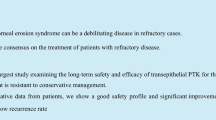Abstract
Introduction
Antibiotics have traditionally been classified as bactericidal or bacteriostatic. Azithromycin belongs to the parent class of macrolides that are characteristically bacteriostatic. Some evidence suggests that this mol-ecule demonstrates bactericidal kill and has concentration-dependent effects. This study tests the hypothesis that azithromycin demonstrates a bactericidal, concentration-dependent antibiotic effect at concentrations corresponding to and exceeding published tear and conjunctival levels.
Methods
The antibacterial activity of different concentrations of azithromycin 1% in DuraSite® (AzaSite®; Inspire Pharmaceuticals Inc, Durham, NC, USA) was evaluated using a kinetics-of-kill model. Recent conjunctivitis isolates of Staphylococcus aureus, Streptococcus pneumoniae or Haemophilus influenzae were exposed to four concentrations of azithromycin (100, 250, 500 and 750 μg/ml). Starting concentrations were similar to the maximum concentrations (Cmax) that have been demonstrated in conjunctiva (83 μg/g) and tears (288 μg/ml) following topical ocular administration. The percentage of surviving bacteria at 30 and 60 minutes following exposure to each concentration were determined.
Results
Azithromycin failed to demonstrate bactericidal activity (i.e. a 3-log reduction in surviving bacteria) against S. aureus, S. pneumoniae or H. influenzae. Furthermore, the rate and extent of antibacterial activity with azithromycin did not change with higher concentrations, even at the highest tested concentration of 750 μg/ml.
Conclusion
Similar to the parent macrolide class, azithromycin demonstrates bacteriostatic activity against common conjunctival pathogens up to the maximum tested concentration of 750 μg/ml (i.e. 2.6-times and 9-times published Cmax tear and conjunctival concentration, respectively). Azithromycin’s bacteriostatic effects and prolonged elimination half-life will likely lead to a corresponding increase in the emergence of macrolide-resistant isolates.
Similar content being viewed by others
References
Pankey GA, Sabath LD. Clinical relevance of bacteriostatic versus bactericidal mechanisms of action in the treatment of Gram-positive bacterial infections. Clin Infect Dis. 2004;38:864–870.
Peterson LR. Shanholtzer CJ. Tests for bactericidal effects of antimicrobial agents: technical performance and clinical relevance. Clin Microb Rev. 1992;5:420–432.
Wispelway B. Clinical implications of pharmacokinetics and pharmacodynamics of fluoroquinolones. Clin Infect Dis. 2005;41:S127–S135.
Shah PM, Junghanns W, Stille W. Bactericidal dose-activity relationships with E. coli, K. pneumoniae and Staph. aureus [in German]. Dtsch Med Wochenschr. 1976;101:325–328.
Mueller M, de la Peña A, Derendorf H. Issues in pharmacokinetics and pharmacodynamics of anti-infective agents: kill curves versus MIC. Antimicrob Agents Chemo. 2004;48:369–377.
Craig WA. Pharmacokinetic/pharmacodynamic parameters: rationale for antibacterial dosing of mice and men. Clin Infect Dis. 1998;26:1–10.
Carbon C. Pharmacodynamics of macrolides, azalides, and streptogramins: effect on extracellular pathogens. Clin Infect Dis. 1998;27:28–32.
Retsema J, Girard A, Schelkly W, et al. Spectrum and mode of action of azithromycin (CP-62,993), a new 15-membered-ring macrolide with improved potency against Gram-negative organisms. Antimicrob Agents Chemo. 1987;31:1939–1947.
Fernandes PB, Bailer R, Swanson R, et al. In vitro and in vivo evaluation of A-56268 (TE-031), a new macrolide. Antimicrob Agents Chemo. 1986;30:865–873.
Clinical and Laboratory Standards Institute. M7-A7 Methods for Dilution Antimicrobial Susceptibility Tests for Bacteria That Grow Aerobically; Approved Standard-Seventh Edition. Wayne, PA: CLSI; 2006;26.
Friedlaender MH, Protzko E. Clinical development of 1% azithromycin in DuraSite, a topical azalide anti-infective for ocular surface therapy. Clin Ophthalmol. 2007;1:3–10.
Si EC, Bowman LM, Roy SD. Ocular bioavailability and systemic levels of an ophthalmic formulation of azithromycin, ISV-401. Invest Ophthalmol Vis Sci. 2003;44. Abstract 1461.
Stratton CW. Dead bugs don’t mutate: susceptibility issues in the emergence of bacterial resistance. Emerging Infect Dis. 2003;9:10–16.
Schito GC, Debbia EA, Marchese A. The evolving threat of antibiotic resistance in Europe: new data from the Alexander Project. J Antimicrob Chem. 2000;46(suppl T1):3–9.
Gay K, Baughman W, Miller Y, et al. The emergence of Streptococcus pneumoniae resistant to macrolide antimicrobial agents: a 6-year population-based assessment. J Infect Dis. 2000;182:1417–1424.
Dagan R, Klugman KP, Craig WA, Baquero F. Evidence to support the rationale that bacterial eradication in respiratory tract infection is an important aim of antimicrobial therapy. J Antimicrob Chem. 2001;47:129–140.
Ohnsman C, Ritterband D, O’Brien T, Girgis D, Kaba A. Comparison of azithromycin and moxifloxacin against bacterial isolates causing conjunctivitis. Curr Med Res Opin. 2007;23:2241–2249.
Malhotra-Kumar S, Lammens C, Coenen S, Van Herck K, Goossens H. Effect of azithromycin and clarithromycin therapy on pharyngeal carriage of macrolide-resistant streptococci in healthy volunteers: a randomised, doubleblind, placebo-controlled study. Lancet. 2007;369:482–490.
Burton MJ, Frick KD, Bailey RL, Boman RJ. Azithromycin for the treatment and control of trachoma. Expert Opin Pharm. 2002;3:113–120.
Chern KC, Shrestha SK, Cavallos V, et al. Alterations in the conjunctival bacterial flora following a single dose of azithromycin in a trachoma endemic area. Br J Ophthalmol. 1999;83:1332–1335.
Author information
Authors and Affiliations
Corresponding author
Rights and permissions
About this article
Cite this article
Dorfman, M.S., Wagner, R.S., Jamison, T. et al. The pharmacodynamic properties of azithromycin in a kinetics-of-kill model and implications for bacterial conjunctivitis treatment. Adv Therapy 25, 208–217 (2008). https://doi.org/10.1007/s12325-008-0034-x
Published:
Issue Date:
DOI: https://doi.org/10.1007/s12325-008-0034-x




